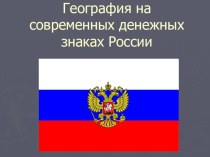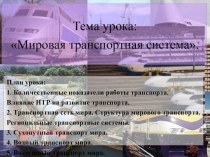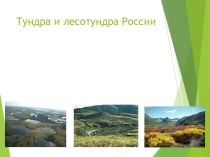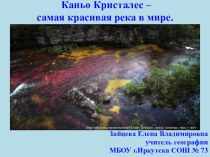- Главная
- Разное
- Бизнес и предпринимательство
- Образование
- Развлечения
- Государство
- Спорт
- Графика
- Культурология
- Еда и кулинария
- Лингвистика
- Религиоведение
- Черчение
- Физкультура
- ИЗО
- Психология
- Социология
- Английский язык
- Астрономия
- Алгебра
- Биология
- География
- Геометрия
- Детские презентации
- Информатика
- История
- Литература
- Маркетинг
- Математика
- Медицина
- Менеджмент
- Музыка
- МХК
- Немецкий язык
- ОБЖ
- Обществознание
- Окружающий мир
- Педагогика
- Русский язык
- Технология
- Физика
- Философия
- Химия
- Шаблоны, картинки для презентаций
- Экология
- Экономика
- Юриспруденция
Что такое findslide.org?
FindSlide.org - это сайт презентаций, докладов, шаблонов в формате PowerPoint.
Обратная связь
Email: Нажмите что бы посмотреть
Презентация на тему Geography of the United States of America
Содержание
- 2. Four U.S. states border Mexico.1. California2. Arizona4. Texas3. New Mexico
- 3. Thirteen states border Canada.1. Washington2. Idaho3. Montana4. North Dakota5. Minnesota
- 4. 6. Michigan7. Ohio8. Pennsylvania
- 5. Now where is state number 13? 9. New York10. Vermont11. New Hampshire12. Maine
- 6. In addition to fifty states, there are
- 7. The most famous landmark in America is
- 8. The capital of the United States is
- 9. Missouri River
- 10. Mississippi River
- 11. American Indians (Native Americans) The best-known tribe
- 12. ? Navajo Indians in World War II
- 13. Regions of the United States Northeast South Midwest West
- 14. The NortheastNortheast Maine, New Hampshire, Vermont, Massachusetts,
- 15. Physical Geography of NortheastNorthern Appalachian mountains run
- 16. Climate and Vegetation of Northeast: Humid ContinentalNo
- 17. Historical Geography of the NortheastThe Northeast has
- 18. Population Geography of the NortheastPopulation is concentrated
- 19. Land Use in the NortheastDairy Farming FarmingTimberMaritime
- 20. Economic GeographyNortheast is the heart of the
- 21. New England LegacyNew England is famous for
- 22. New England PoliticsNew England is generally progressive
- 23. The SouthStates included: North Carolina, South Carolina,
- 24. Climate and Vegetation of the SouthHumid subtropical,
- 25. Economic Geography of the SouthHistorically based on
- 26. Political ActivityThe South is known for its
- 27. MidwestIncluded States: Michigan, Ohio, Indiana, Illinois, Wisconsin, Minnesota, and IowaTransition States: Pennsylvania, Missouri
- 28. Physical Geography of MidwestFlat landscape, with river basins.Distinctive Great Lakes, which provide for shipping.
- 29. Climate of the Midwest: Humid ContinentalNo
- 30. Historical Geography of the MidwestThe Mid-west was
- 31. PopulationLarge cities include Chicago and DetroitThe region
- 32. Economic GeographyDairy Farming in Wisconsin and MinnesotaFruit
- 33. Corn is most notably grown, but soybeans,
- 34. Great Plains RegionStrip of States through the
- 35. Physical Geography of the Great Plains
- 36. Climate of the Great PlainsThis area receives
- 37. Historical Geography of the Great PlainsBefore Americans
- 38. Homestead Act of 1862This act provided each
- 39. Population of the Great Plains: Rural and declining
- 40. Mountain and Basin States States included: New
- 41. Physical Geography Characterized by the steep and jagged Rocky Mountain Range
- 42. ClimateHighland climate is found throughout the RockiesDesertsIn
- 43. Historical Geography Mining townsOutlaws (Wild West)Cattle/Sheep GrazingReservation LandsLas Vegas and Reno- Gambling townsNational Park Service
- 44. Population GeographyNot densely populated. Major urban centers include: Denver, Salt Lake City, Phoenix.
- 45. Economic ActivityGrazingMiningTourismLumber
- 46. Pacific Coast StatesCalifornia, Oregon and Washington
- 47. Physical Geography of West CoastMountain Ranges (Sierra
- 48. Southern CaliforniaThe continual presence of natural hazards,
- 49. Population GeographyMore dense along the coastal areas,
- 50. Economic Activity Movie IndustryWine (Napa and Sonoma)TourismFishing on the coast
- 51. Скачать презентацию
- 52. Похожие презентации
Four U.S. states border Mexico.1. California2. Arizona4. Texas3. New Mexico

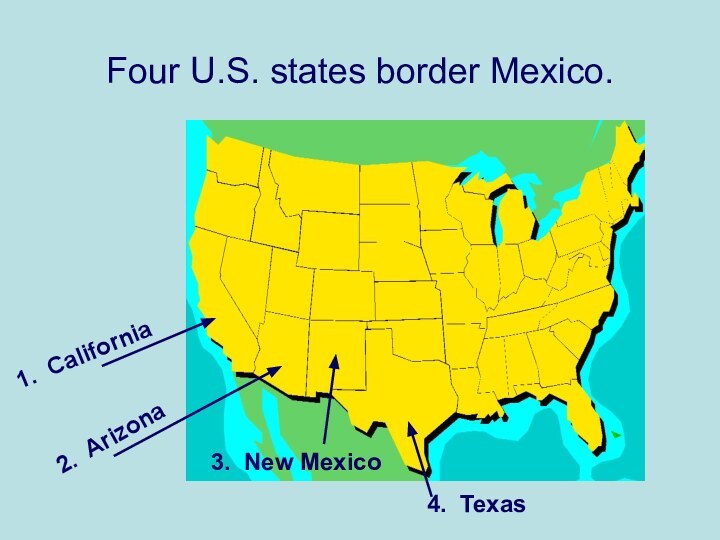




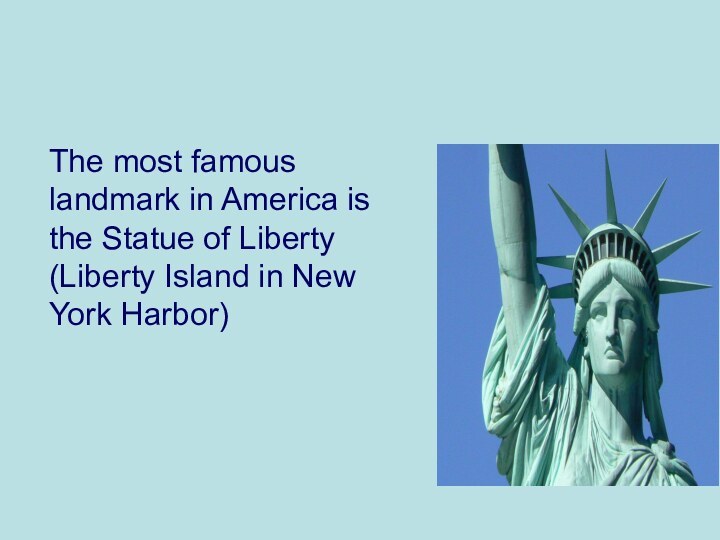


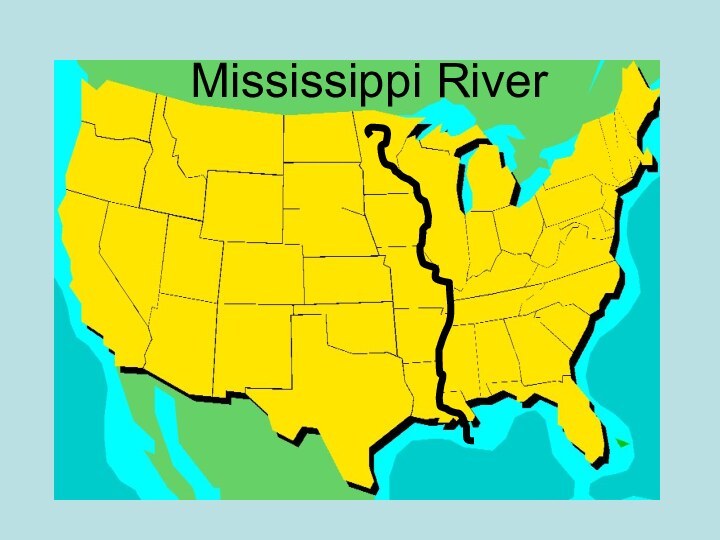
















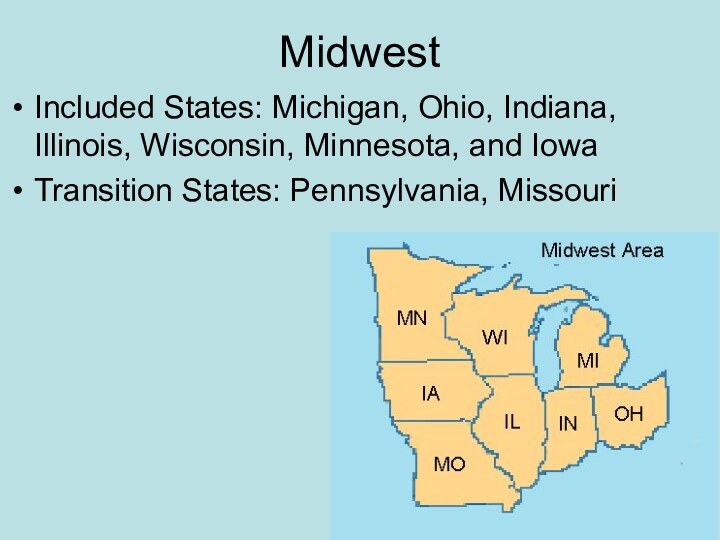
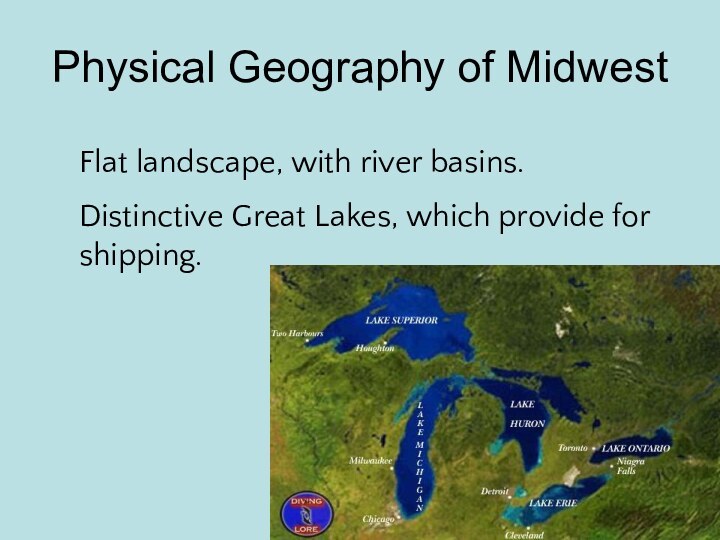











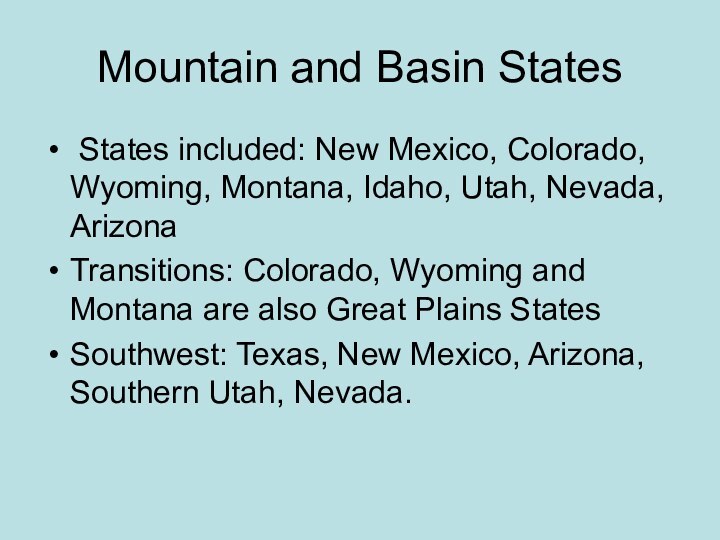



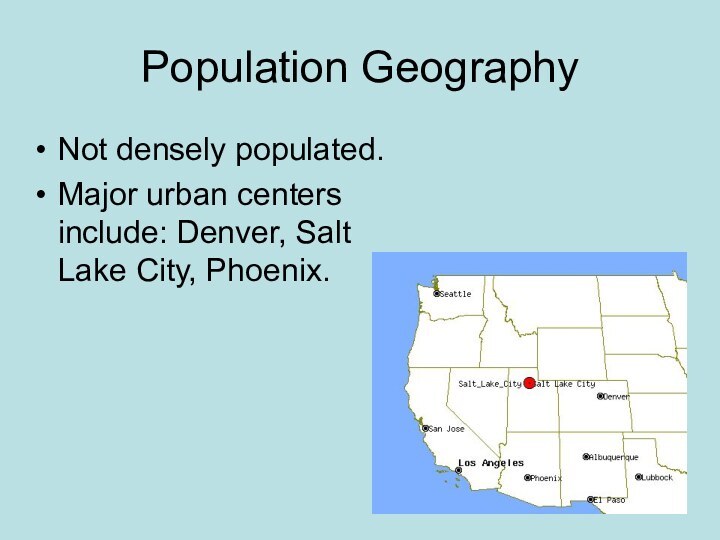







Слайд 6 In addition to fifty states, there are five
U.S. territories.
Two are in the Atlantic:
Puerto Rico
U.S. Virgin Islands
And
three are in the Pacific:American Samoa
Northern Mariana Islands
Guam
Слайд 7 The most famous landmark in America is the
Statue of Liberty (Liberty Island in New York Harbor)
Слайд 8 The capital of the United States is Washington,
D.C.
D. C. stands for District of Columbia.
The
District of Columbia is not a state.
Слайд 11
American Indians (Native Americans)
The best-known tribe in
North Carolina is the Cherokee.
There are many other Indian
tribes across the United States. Which ones can you name?
Слайд 14
The Northeast
Northeast
Maine, New Hampshire, Vermont, Massachusetts, Connecticut,
Rhode Island, New York, New Jersey, Pennsylvania, Delaware, Maryland,
and the District of Columbia
Слайд 15
Physical Geography of Northeast
Northern Appalachian mountains run through
most of the northeastern states, causing little farmland, except
in valley areasDeep bays exist, allowing for port towns
Jagged, rocky coastline in northern areas
Слайд 16
Climate and Vegetation of Northeast: Humid Continental
No Dry
Season - the area receives precipitation throughout the year.
Cold,
snowy winters and hot summers. Moderate growing season that decreases to north.
Vegetation is mixed forests with deciduous and coniferous trees.
Слайд 17
Historical Geography of the Northeast
The Northeast has the
longest history of European settlement .
Historically, the Northeast has
been the gateway to immigrants.Established itself as the financial and manufacturing hub early in the industrial revolution.
Слайд 18
Population Geography of the Northeast
Population is concentrated in
the Megalopolis that runs from Boston to Washington (AKA
Bosnywash).This is the most densely populated region in the United States.
Слайд 19
Land Use in the Northeast
Dairy Farming
Farming
Timber
Maritime Activity
Some
Mining
Note: As you go north, the growing season shortens,
which limits farming. In part of the Northeast, timber is a primary economic activity.
Слайд 20
Economic Geography
Northeast is the heart of the Manufacturing
core, but lately has been termed the RUST BELT.
This extends into the Midwest.Why was it called the Rust belt? Where have industries relocated? Why?
Слайд 21
New England Legacy
New England is famous for its
“prep schools” and is home to some of the
most elite Universities in the world: Harvard, Yale, MIT, Boston College, Brown, Dartmouth, etc.One of the best resources New England has is its educated population.
Слайд 22
New England Politics
New England is generally progressive in
politics and states usually are affiliated with the Democratic
party, although some rural areas tend to vote Republican.
Слайд 23
The South
States included: North Carolina, South Carolina, Florida,
Georgia, Alabama, Mississippi, Tennessee, Arkansas, and Louisiana.
Transition States: Virginia,
W. Virginia, Kentucky, Missouri, Oklahoma, and Texas
Слайд 24
Climate and Vegetation of the South
Humid subtropical, with
hot, humid summers and long growing season. Winters are
mild, seldom snow. No dry season.Vegetation: Mixed forests. The South is known for plants such as live oaks, magnolia trees, flowering dogwoods.
Слайд 25
Economic Geography of the South
Historically based on agriculture,
with tobacco and cotton being the first cash crops.
Fishing
is a common activity in Gulf Coast States.Tourism along the Gulf Coast, especially Florida.
Oil Industry is located in the Gulf and in cities like Houston and Beaumont, close to continental shelf drilling.
Слайд 26
Political Activity
The South is known for its conservatism.
The Republican Party dominates the South as a result.
Resistance
to same-sex marriage, abortion, feminism, desegregation, and the abolition of slavery are part of the political history of the South.
Слайд 27
Midwest
Included States: Michigan, Ohio, Indiana, Illinois, Wisconsin, Minnesota,
and Iowa
Transition States: Pennsylvania, Missouri
Слайд 28
Physical Geography of Midwest
Flat landscape, with river basins.
Distinctive
Great Lakes, which provide for shipping.
Слайд 29
Climate of the Midwest:
Humid Continental
No Dry Season-
this area receives precipitation throughout the year.
Cold, snowy winters
and hot summers. Moderate growing season that decreases as you go north.
Vegetation is mixed forests with deciduous and coniferous trees.
Слайд 30
Historical Geography of the Midwest
The Mid-west was considered
the “Western Frontier”, hence the name.
Historically known as the
breadbasket of the U.S., as this is also an agricultural region.Also known as a manufacturing, blue-collar hub of the U.S.
Слайд 31
Population
Large cities include Chicago and Detroit
The region is
evenly distributed.
Population is dense along the Great Lakes.
Слайд 32
Economic Geography
Dairy Farming in Wisconsin and Minnesota
Fruit Orchards
in Michigan
Corn in Indiana, Illinois, and Iowa
Manufacturing in urban
cities along Great Lakes, like Pittsburgh, Cleveland, Detroit and Chicago (Steel Towns).
Слайд 33
Corn is most notably grown, but soybeans, wheat,
and fruits orchards are also commonly found throughout the
Midwest.In which state in the Midwest are dairy products famous?
Слайд 34
Great Plains Region
Strip of States through the center
of the Country.
Includes: Kansas, Nebraska,
South Dakota, and North
Dakota.Transition States: Oklahoma,
Panhandle of Texas,
Eastern Colorado, Wyoming
and Montana.
,
Слайд 35
Physical Geography of
the Great Plains
The Great
Plains are also called the High Plains, as the
elevation increases gradually as you go west.Generally flat with some rolling hills.
Major River Basins: Red River, Arkansas River, Platte River, and the Missouri River.
Слайд 36
Climate of the Great Plains
This area receives little
rainfall (less than 18 in. a year on average).
Cold
Winters, especially in the northern areas.
Слайд 37
Historical Geography of the Great Plains
Before Americans settled
the frontier, the Great Plains was home to several
Indigenous culture, most notably the Sioux and the Cheyenne.During the 19th century, the Great Plains became the staging point of war between the native people and the American settlers.
Слайд 38
Homestead Act of 1862
This act provided each settler
with 160 acres of land, as long as he
cultivated the land.This caused a rush of settlers to the Great Plains region in the 1800s.
Ironically, the Great Plains has lost a third of its population since 1920. Kansas has 6,000 ghost towns.
Слайд 40
Mountain and Basin States
States included: New Mexico,
Colorado, Wyoming, Montana, Idaho, Utah, Nevada, Arizona
Transitions: Colorado, Wyoming
and Montana are also Great Plains StatesSouthwest: Texas, New Mexico, Arizona, Southern Utah, Nevada.
Слайд 42
Climate
Highland climate is found throughout the Rockies
Deserts
In general,
the area is
arid.
Farming is done
with irrigation.
Слайд 43
Historical Geography
Mining towns
Outlaws (Wild West)
Cattle/Sheep Grazing
Reservation Lands
Las
Vegas and Reno-
Gambling towns
National Park Service
Слайд 44
Population Geography
Not densely populated.
Major urban centers include:
Denver, Salt Lake City, Phoenix.
Слайд 47
Physical Geography of West Coast
Mountain Ranges (Sierra Nevada
and the Cascades) and Rocky coastlines due to subduction
forces.Physical hazard exist across
the region due to tectonic forces.
Слайд 48
Southern California
The continual presence of natural hazards, including
fire, flood, earthquakes, and intense drought, has done little
to reduce the growth of this
area
San Andreas Fault
Los Angeles is the 2nd largest
city in the U.S.






